Mallika Food Enterprises: International HRM Analysis Report
VerifiedAdded on 2019/10/01
|17
|4758
|384
Report
AI Summary
This report provides a comprehensive analysis of the international human resource management (IHRM) strategies of Mallika Food Enterprises as it transitions from a national to a multinational business. The report begins with an executive summary and table of contents, followed by an introduction to the company and its goals. It explores the characteristics of multinational companies (MNCs) and compares them to Mallika Enterprises, highlighting similarities and differences. The report then examines globalization and regionalization across four international locations: Dubai, Ankara, Manila, and Mumbai, applying convergence theory and Hofstede's Cultural Dimensions Model to understand cultural nuances. Furthermore, it delves into the operation of HR functions, specifically training and development, recruitment, and selection, within these locations. The report also addresses the challenges associated with global HR practices and concludes with recommendations for Mallika's HR management strategy. Finally, the report includes a comprehensive reference list. This report is a valuable resource for students studying international business and human resource management.
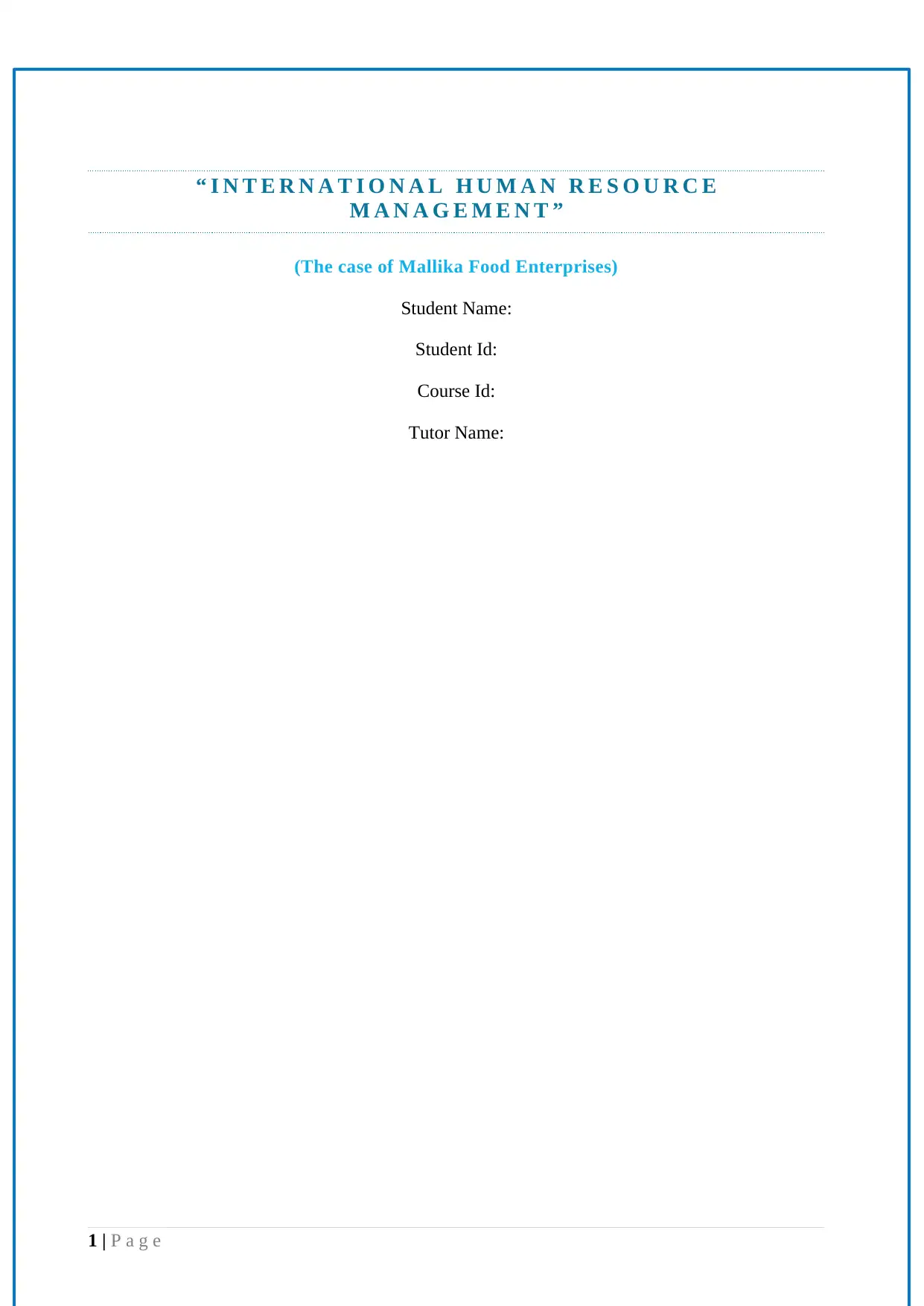
“ I N T E R N A T I O N A L H U M A N R E S O U R C E
M A N A G E M E N T ”
(The case of Mallika Food Enterprises)
Student Name:
Student Id:
Course Id:
Tutor Name:
1 | P a g e
M A N A G E M E N T ”
(The case of Mallika Food Enterprises)
Student Name:
Student Id:
Course Id:
Tutor Name:
1 | P a g e
Paraphrase This Document
Need a fresh take? Get an instant paraphrase of this document with our AI Paraphraser
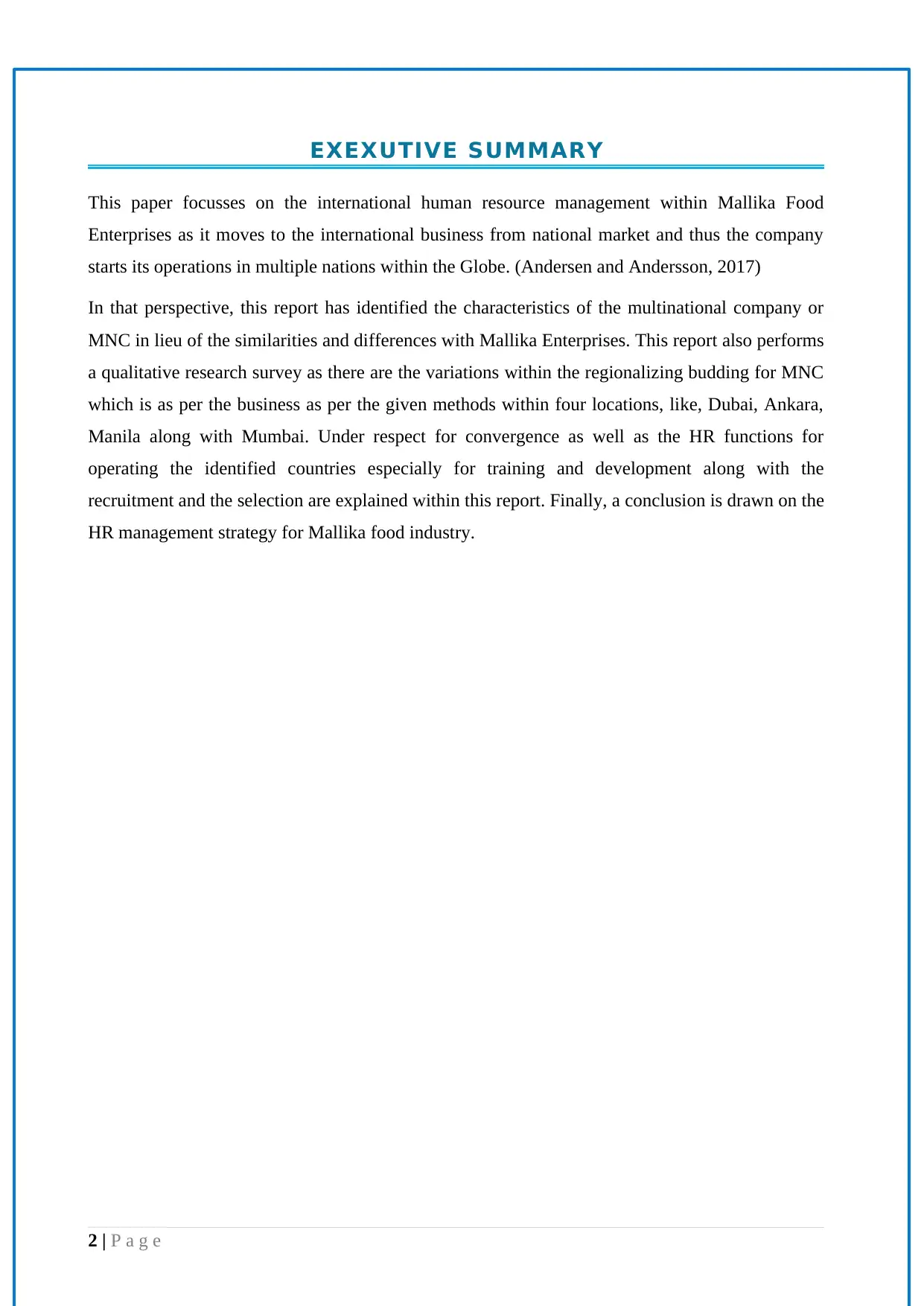
EXEXUTIVE SUMMARY
This paper focusses on the international human resource management within Mallika Food
Enterprises as it moves to the international business from national market and thus the company
starts its operations in multiple nations within the Globe. (Andersen and Andersson, 2017)
In that perspective, this report has identified the characteristics of the multinational company or
MNC in lieu of the similarities and differences with Mallika Enterprises. This report also performs
a qualitative research survey as there are the variations within the regionalizing budding for MNC
which is as per the business as per the given methods within four locations, like, Dubai, Ankara,
Manila along with Mumbai. Under respect for convergence as well as the HR functions for
operating the identified countries especially for training and development along with the
recruitment and the selection are explained within this report. Finally, a conclusion is drawn on the
HR management strategy for Mallika food industry.
2 | P a g e
This paper focusses on the international human resource management within Mallika Food
Enterprises as it moves to the international business from national market and thus the company
starts its operations in multiple nations within the Globe. (Andersen and Andersson, 2017)
In that perspective, this report has identified the characteristics of the multinational company or
MNC in lieu of the similarities and differences with Mallika Enterprises. This report also performs
a qualitative research survey as there are the variations within the regionalizing budding for MNC
which is as per the business as per the given methods within four locations, like, Dubai, Ankara,
Manila along with Mumbai. Under respect for convergence as well as the HR functions for
operating the identified countries especially for training and development along with the
recruitment and the selection are explained within this report. Finally, a conclusion is drawn on the
HR management strategy for Mallika food industry.
2 | P a g e
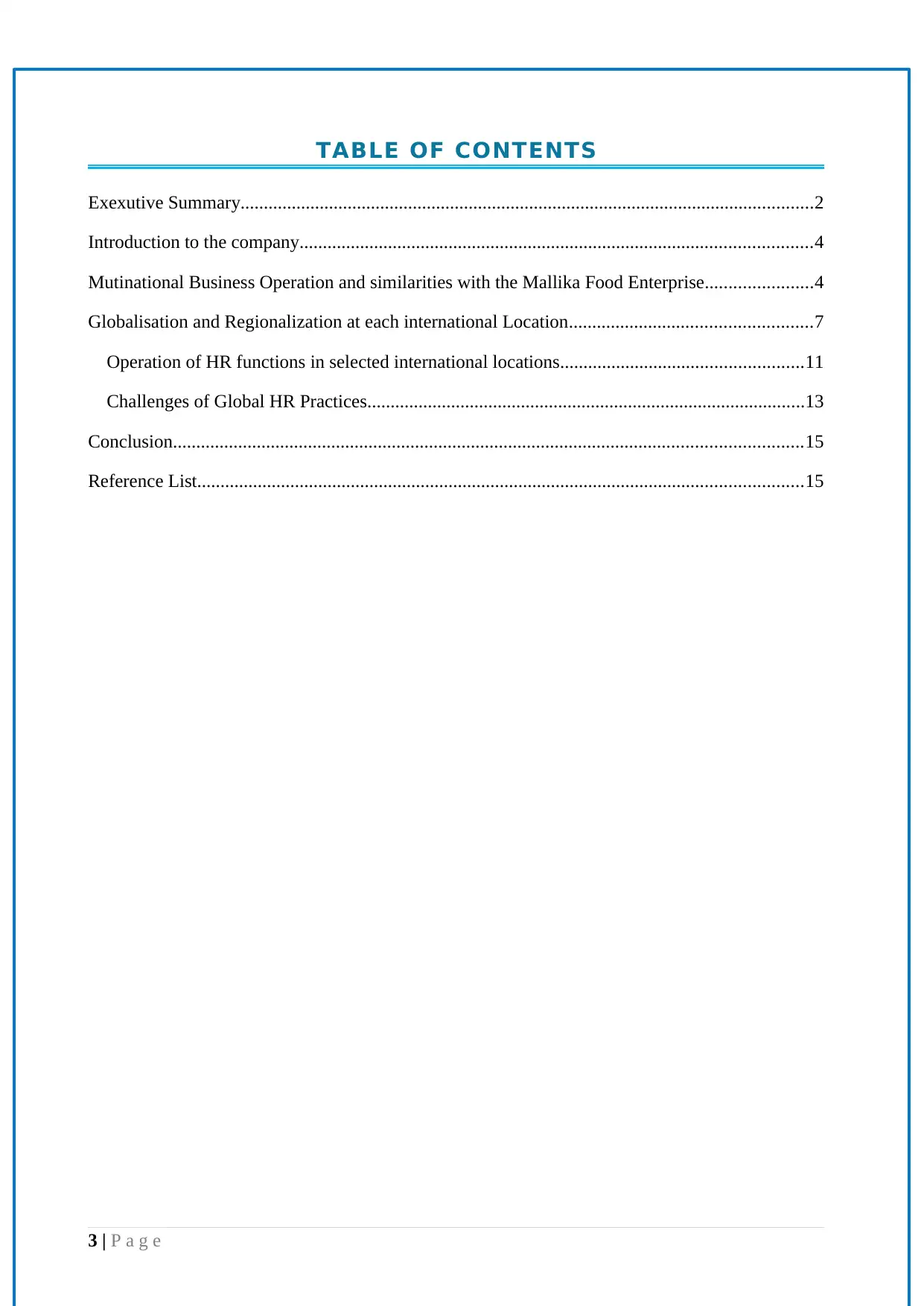
TABLE OF CONTENTS
Exexutive Summary...........................................................................................................................2
Introduction to the company..............................................................................................................4
Mutinational Business Operation and similarities with the Mallika Food Enterprise.......................4
Globalisation and Regionalization at each international Location....................................................7
Operation of HR functions in selected international locations....................................................11
Challenges of Global HR Practices..............................................................................................13
Conclusion.......................................................................................................................................15
Reference List..................................................................................................................................15
3 | P a g e
Exexutive Summary...........................................................................................................................2
Introduction to the company..............................................................................................................4
Mutinational Business Operation and similarities with the Mallika Food Enterprise.......................4
Globalisation and Regionalization at each international Location....................................................7
Operation of HR functions in selected international locations....................................................11
Challenges of Global HR Practices..............................................................................................13
Conclusion.......................................................................................................................................15
Reference List..................................................................................................................................15
3 | P a g e
⊘ This is a preview!⊘
Do you want full access?
Subscribe today to unlock all pages.

Trusted by 1+ million students worldwide
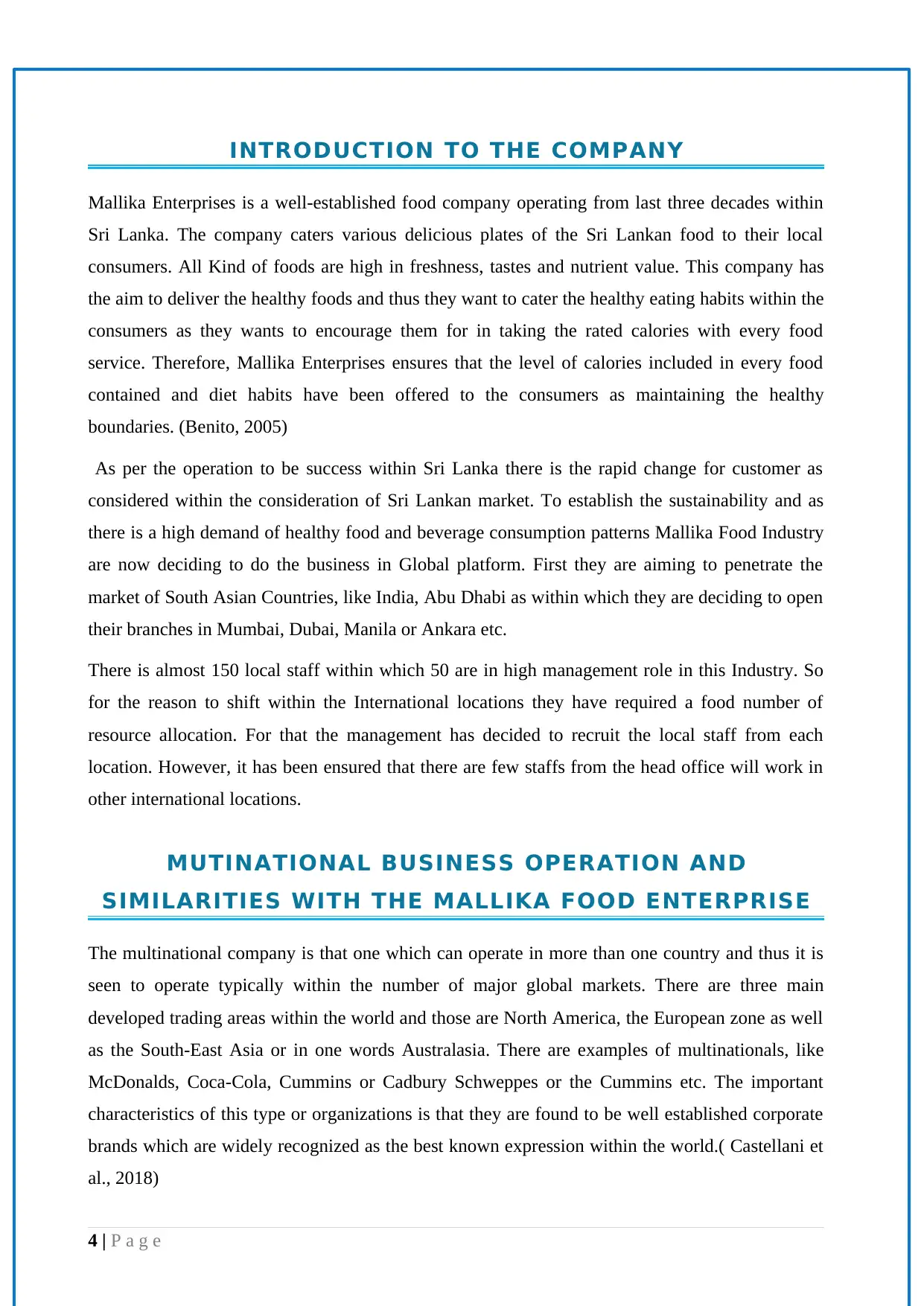
INTRODUCTION TO THE COMPANY
Mallika Enterprises is a well-established food company operating from last three decades within
Sri Lanka. The company caters various delicious plates of the Sri Lankan food to their local
consumers. All Kind of foods are high in freshness, tastes and nutrient value. This company has
the aim to deliver the healthy foods and thus they want to cater the healthy eating habits within the
consumers as they wants to encourage them for in taking the rated calories with every food
service. Therefore, Mallika Enterprises ensures that the level of calories included in every food
contained and diet habits have been offered to the consumers as maintaining the healthy
boundaries. (Benito, 2005)
As per the operation to be success within Sri Lanka there is the rapid change for customer as
considered within the consideration of Sri Lankan market. To establish the sustainability and as
there is a high demand of healthy food and beverage consumption patterns Mallika Food Industry
are now deciding to do the business in Global platform. First they are aiming to penetrate the
market of South Asian Countries, like India, Abu Dhabi as within which they are deciding to open
their branches in Mumbai, Dubai, Manila or Ankara etc.
There is almost 150 local staff within which 50 are in high management role in this Industry. So
for the reason to shift within the International locations they have required a food number of
resource allocation. For that the management has decided to recruit the local staff from each
location. However, it has been ensured that there are few staffs from the head office will work in
other international locations.
MUTINATIONAL BUSINESS OPERATION AND
SIMILARITIES WITH THE MALLIKA FOOD ENTERPRISE
The multinational company is that one which can operate in more than one country and thus it is
seen to operate typically within the number of major global markets. There are three main
developed trading areas within the world and those are North America, the European zone as well
as the South-East Asia or in one words Australasia. There are examples of multinationals, like
McDonalds, Coca-Cola, Cummins or Cadbury Schweppes or the Cummins etc. The important
characteristics of this type or organizations is that they are found to be well established corporate
brands which are widely recognized as the best known expression within the world.( Castellani et
al., 2018)
4 | P a g e
Mallika Enterprises is a well-established food company operating from last three decades within
Sri Lanka. The company caters various delicious plates of the Sri Lankan food to their local
consumers. All Kind of foods are high in freshness, tastes and nutrient value. This company has
the aim to deliver the healthy foods and thus they want to cater the healthy eating habits within the
consumers as they wants to encourage them for in taking the rated calories with every food
service. Therefore, Mallika Enterprises ensures that the level of calories included in every food
contained and diet habits have been offered to the consumers as maintaining the healthy
boundaries. (Benito, 2005)
As per the operation to be success within Sri Lanka there is the rapid change for customer as
considered within the consideration of Sri Lankan market. To establish the sustainability and as
there is a high demand of healthy food and beverage consumption patterns Mallika Food Industry
are now deciding to do the business in Global platform. First they are aiming to penetrate the
market of South Asian Countries, like India, Abu Dhabi as within which they are deciding to open
their branches in Mumbai, Dubai, Manila or Ankara etc.
There is almost 150 local staff within which 50 are in high management role in this Industry. So
for the reason to shift within the International locations they have required a food number of
resource allocation. For that the management has decided to recruit the local staff from each
location. However, it has been ensured that there are few staffs from the head office will work in
other international locations.
MUTINATIONAL BUSINESS OPERATION AND
SIMILARITIES WITH THE MALLIKA FOOD ENTERPRISE
The multinational company is that one which can operate in more than one country and thus it is
seen to operate typically within the number of major global markets. There are three main
developed trading areas within the world and those are North America, the European zone as well
as the South-East Asia or in one words Australasia. There are examples of multinationals, like
McDonalds, Coca-Cola, Cummins or Cadbury Schweppes or the Cummins etc. The important
characteristics of this type or organizations is that they are found to be well established corporate
brands which are widely recognized as the best known expression within the world.( Castellani et
al., 2018)
4 | P a g e
Paraphrase This Document
Need a fresh take? Get an instant paraphrase of this document with our AI Paraphraser
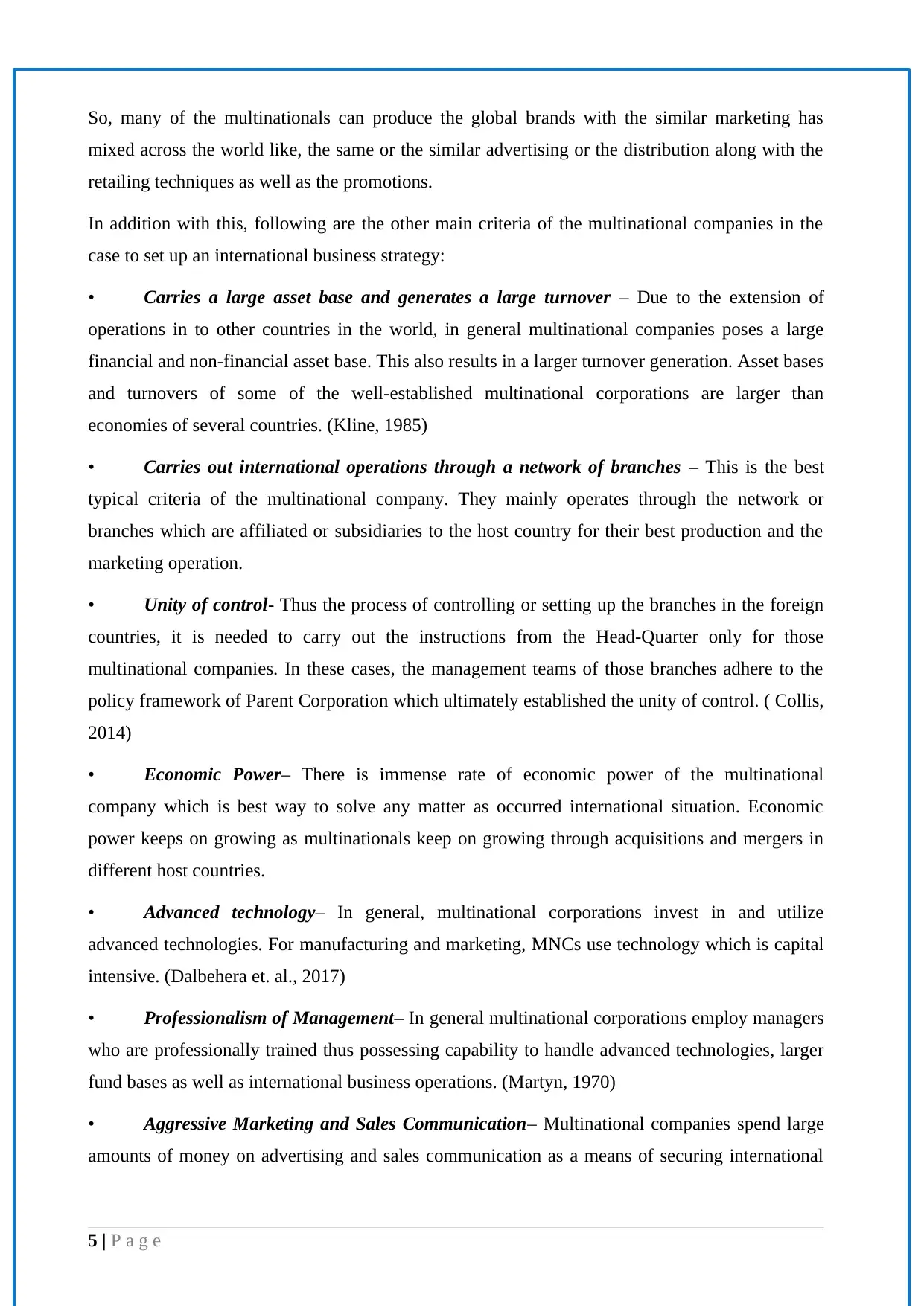
So, many of the multinationals can produce the global brands with the similar marketing has
mixed across the world like, the same or the similar advertising or the distribution along with the
retailing techniques as well as the promotions.
In addition with this, following are the other main criteria of the multinational companies in the
case to set up an international business strategy:
• Carries a large asset base and generates a large turnover – Due to the extension of
operations in to other countries in the world, in general multinational companies poses a large
financial and non-financial asset base. This also results in a larger turnover generation. Asset bases
and turnovers of some of the well-established multinational corporations are larger than
economies of several countries. (Kline, 1985)
• Carries out international operations through a network of branches – This is the best
typical criteria of the multinational company. They mainly operates through the network or
branches which are affiliated or subsidiaries to the host country for their best production and the
marketing operation.
• Unity of control- Thus the process of controlling or setting up the branches in the foreign
countries, it is needed to carry out the instructions from the Head-Quarter only for those
multinational companies. In these cases, the management teams of those branches adhere to the
policy framework of Parent Corporation which ultimately established the unity of control. ( Collis,
2014)
• Economic Power– There is immense rate of economic power of the multinational
company which is best way to solve any matter as occurred international situation. Economic
power keeps on growing as multinationals keep on growing through acquisitions and mergers in
different host countries.
• Advanced technology– In general, multinational corporations invest in and utilize
advanced technologies. For manufacturing and marketing, MNCs use technology which is capital
intensive. (Dalbehera et. al., 2017)
• Professionalism of Management– In general multinational corporations employ managers
who are professionally trained thus possessing capability to handle advanced technologies, larger
fund bases as well as international business operations. (Martyn, 1970)
• Aggressive Marketing and Sales Communication– Multinational companies spend large
amounts of money on advertising and sales communication as a means of securing international
5 | P a g e
mixed across the world like, the same or the similar advertising or the distribution along with the
retailing techniques as well as the promotions.
In addition with this, following are the other main criteria of the multinational companies in the
case to set up an international business strategy:
• Carries a large asset base and generates a large turnover – Due to the extension of
operations in to other countries in the world, in general multinational companies poses a large
financial and non-financial asset base. This also results in a larger turnover generation. Asset bases
and turnovers of some of the well-established multinational corporations are larger than
economies of several countries. (Kline, 1985)
• Carries out international operations through a network of branches – This is the best
typical criteria of the multinational company. They mainly operates through the network or
branches which are affiliated or subsidiaries to the host country for their best production and the
marketing operation.
• Unity of control- Thus the process of controlling or setting up the branches in the foreign
countries, it is needed to carry out the instructions from the Head-Quarter only for those
multinational companies. In these cases, the management teams of those branches adhere to the
policy framework of Parent Corporation which ultimately established the unity of control. ( Collis,
2014)
• Economic Power– There is immense rate of economic power of the multinational
company which is best way to solve any matter as occurred international situation. Economic
power keeps on growing as multinationals keep on growing through acquisitions and mergers in
different host countries.
• Advanced technology– In general, multinational corporations invest in and utilize
advanced technologies. For manufacturing and marketing, MNCs use technology which is capital
intensive. (Dalbehera et. al., 2017)
• Professionalism of Management– In general multinational corporations employ managers
who are professionally trained thus possessing capability to handle advanced technologies, larger
fund bases as well as international business operations. (Martyn, 1970)
• Aggressive Marketing and Sales Communication– Multinational companies spend large
amounts of money on advertising and sales communication as a means of securing international
5 | P a g e
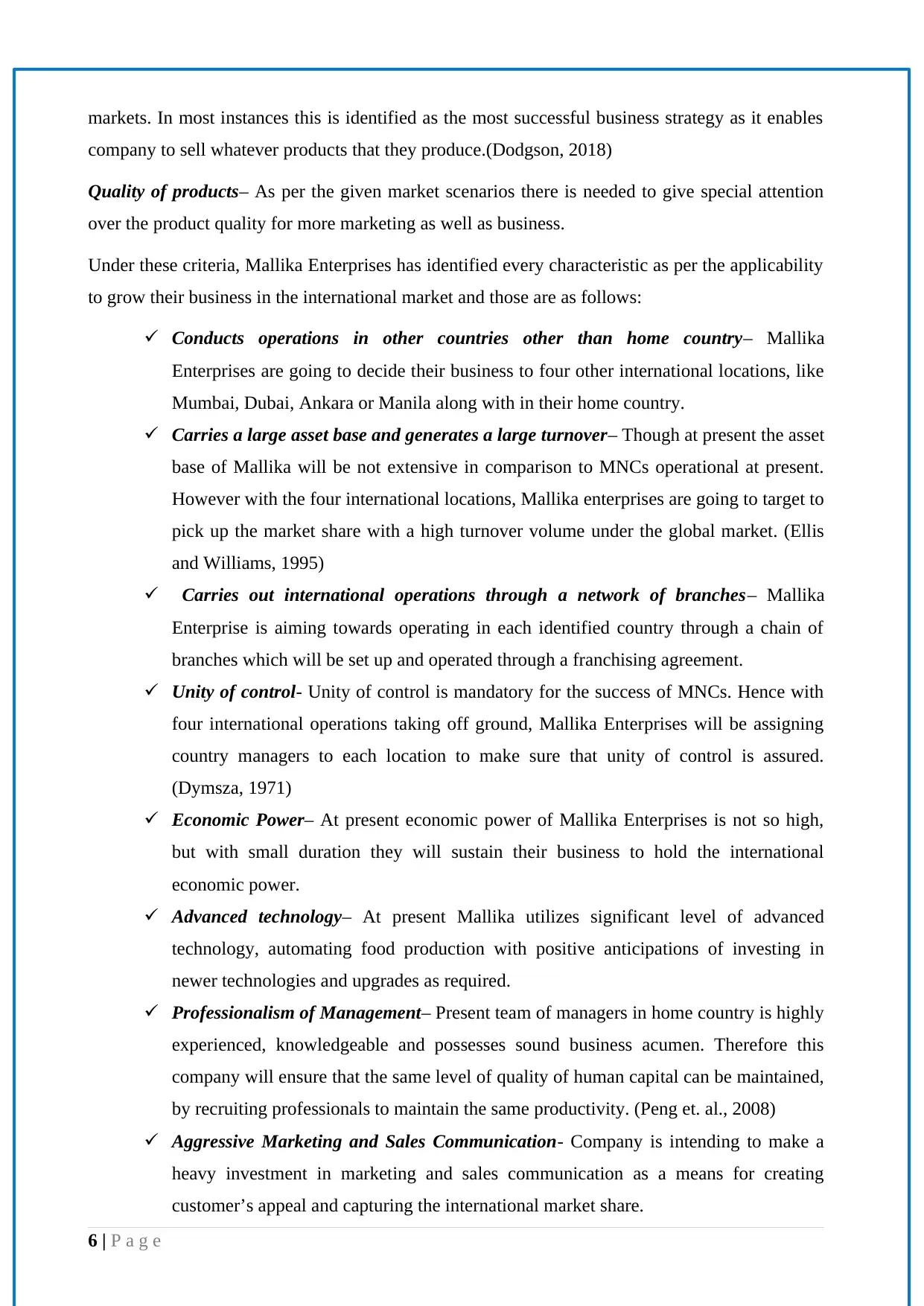
markets. In most instances this is identified as the most successful business strategy as it enables
company to sell whatever products that they produce.(Dodgson, 2018)
Quality of products– As per the given market scenarios there is needed to give special attention
over the product quality for more marketing as well as business.
Under these criteria, Mallika Enterprises has identified every characteristic as per the applicability
to grow their business in the international market and those are as follows:
Conducts operations in other countries other than home country– Mallika
Enterprises are going to decide their business to four other international locations, like
Mumbai, Dubai, Ankara or Manila along with in their home country.
Carries a large asset base and generates a large turnover– Though at present the asset
base of Mallika will be not extensive in comparison to MNCs operational at present.
However with the four international locations, Mallika enterprises are going to target to
pick up the market share with a high turnover volume under the global market. (Ellis
and Williams, 1995)
Carries out international operations through a network of branches– Mallika
Enterprise is aiming towards operating in each identified country through a chain of
branches which will be set up and operated through a franchising agreement.
Unity of control- Unity of control is mandatory for the success of MNCs. Hence with
four international operations taking off ground, Mallika Enterprises will be assigning
country managers to each location to make sure that unity of control is assured.
(Dymsza, 1971)
Economic Power– At present economic power of Mallika Enterprises is not so high,
but with small duration they will sustain their business to hold the international
economic power.
Advanced technology– At present Mallika utilizes significant level of advanced
technology, automating food production with positive anticipations of investing in
newer technologies and upgrades as required.
Professionalism of Management– Present team of managers in home country is highly
experienced, knowledgeable and possesses sound business acumen. Therefore this
company will ensure that the same level of quality of human capital can be maintained,
by recruiting professionals to maintain the same productivity. (Peng et. al., 2008)
Aggressive Marketing and Sales Communication- Company is intending to make a
heavy investment in marketing and sales communication as a means for creating
customer’s appeal and capturing the international market share.
6 | P a g e
company to sell whatever products that they produce.(Dodgson, 2018)
Quality of products– As per the given market scenarios there is needed to give special attention
over the product quality for more marketing as well as business.
Under these criteria, Mallika Enterprises has identified every characteristic as per the applicability
to grow their business in the international market and those are as follows:
Conducts operations in other countries other than home country– Mallika
Enterprises are going to decide their business to four other international locations, like
Mumbai, Dubai, Ankara or Manila along with in their home country.
Carries a large asset base and generates a large turnover– Though at present the asset
base of Mallika will be not extensive in comparison to MNCs operational at present.
However with the four international locations, Mallika enterprises are going to target to
pick up the market share with a high turnover volume under the global market. (Ellis
and Williams, 1995)
Carries out international operations through a network of branches– Mallika
Enterprise is aiming towards operating in each identified country through a chain of
branches which will be set up and operated through a franchising agreement.
Unity of control- Unity of control is mandatory for the success of MNCs. Hence with
four international operations taking off ground, Mallika Enterprises will be assigning
country managers to each location to make sure that unity of control is assured.
(Dymsza, 1971)
Economic Power– At present economic power of Mallika Enterprises is not so high,
but with small duration they will sustain their business to hold the international
economic power.
Advanced technology– At present Mallika utilizes significant level of advanced
technology, automating food production with positive anticipations of investing in
newer technologies and upgrades as required.
Professionalism of Management– Present team of managers in home country is highly
experienced, knowledgeable and possesses sound business acumen. Therefore this
company will ensure that the same level of quality of human capital can be maintained,
by recruiting professionals to maintain the same productivity. (Peng et. al., 2008)
Aggressive Marketing and Sales Communication- Company is intending to make a
heavy investment in marketing and sales communication as a means for creating
customer’s appeal and capturing the international market share.
6 | P a g e
⊘ This is a preview!⊘
Do you want full access?
Subscribe today to unlock all pages.

Trusted by 1+ million students worldwide
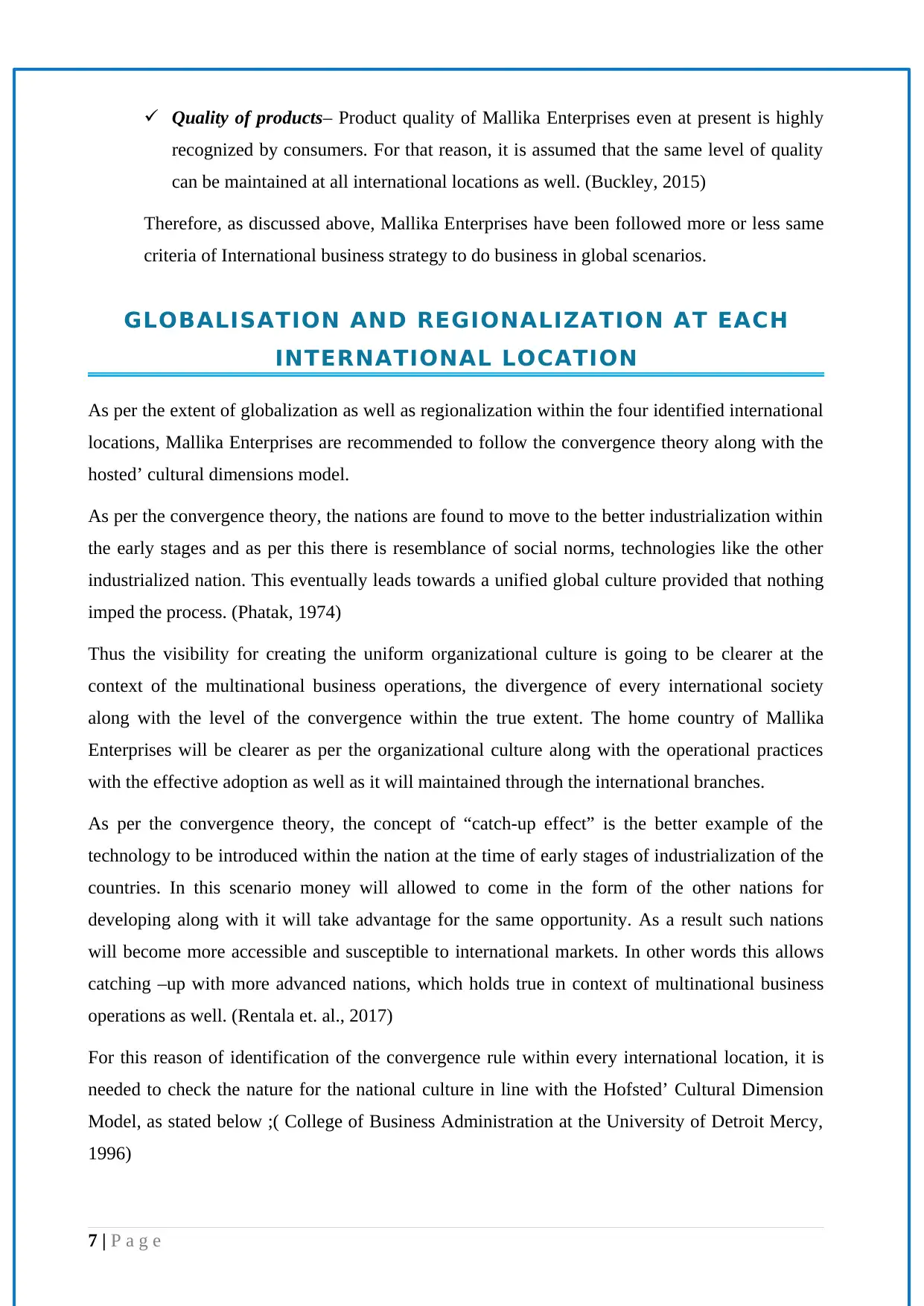
Quality of products– Product quality of Mallika Enterprises even at present is highly
recognized by consumers. For that reason, it is assumed that the same level of quality
can be maintained at all international locations as well. (Buckley, 2015)
Therefore, as discussed above, Mallika Enterprises have been followed more or less same
criteria of International business strategy to do business in global scenarios.
GLOBALISATION AND REGIONALIZATION AT EACH
INTERNATIONAL LOCATION
As per the extent of globalization as well as regionalization within the four identified international
locations, Mallika Enterprises are recommended to follow the convergence theory along with the
hosted’ cultural dimensions model.
As per the convergence theory, the nations are found to move to the better industrialization within
the early stages and as per this there is resemblance of social norms, technologies like the other
industrialized nation. This eventually leads towards a unified global culture provided that nothing
imped the process. (Phatak, 1974)
Thus the visibility for creating the uniform organizational culture is going to be clearer at the
context of the multinational business operations, the divergence of every international society
along with the level of the convergence within the true extent. The home country of Mallika
Enterprises will be clearer as per the organizational culture along with the operational practices
with the effective adoption as well as it will maintained through the international branches.
As per the convergence theory, the concept of “catch-up effect” is the better example of the
technology to be introduced within the nation at the time of early stages of industrialization of the
countries. In this scenario money will allowed to come in the form of the other nations for
developing along with it will take advantage for the same opportunity. As a result such nations
will become more accessible and susceptible to international markets. In other words this allows
catching –up with more advanced nations, which holds true in context of multinational business
operations as well. (Rentala et. al., 2017)
For this reason of identification of the convergence rule within every international location, it is
needed to check the nature for the national culture in line with the Hofsted’ Cultural Dimension
Model, as stated below ;( College of Business Administration at the University of Detroit Mercy,
1996)
7 | P a g e
recognized by consumers. For that reason, it is assumed that the same level of quality
can be maintained at all international locations as well. (Buckley, 2015)
Therefore, as discussed above, Mallika Enterprises have been followed more or less same
criteria of International business strategy to do business in global scenarios.
GLOBALISATION AND REGIONALIZATION AT EACH
INTERNATIONAL LOCATION
As per the extent of globalization as well as regionalization within the four identified international
locations, Mallika Enterprises are recommended to follow the convergence theory along with the
hosted’ cultural dimensions model.
As per the convergence theory, the nations are found to move to the better industrialization within
the early stages and as per this there is resemblance of social norms, technologies like the other
industrialized nation. This eventually leads towards a unified global culture provided that nothing
imped the process. (Phatak, 1974)
Thus the visibility for creating the uniform organizational culture is going to be clearer at the
context of the multinational business operations, the divergence of every international society
along with the level of the convergence within the true extent. The home country of Mallika
Enterprises will be clearer as per the organizational culture along with the operational practices
with the effective adoption as well as it will maintained through the international branches.
As per the convergence theory, the concept of “catch-up effect” is the better example of the
technology to be introduced within the nation at the time of early stages of industrialization of the
countries. In this scenario money will allowed to come in the form of the other nations for
developing along with it will take advantage for the same opportunity. As a result such nations
will become more accessible and susceptible to international markets. In other words this allows
catching –up with more advanced nations, which holds true in context of multinational business
operations as well. (Rentala et. al., 2017)
For this reason of identification of the convergence rule within every international location, it is
needed to check the nature for the national culture in line with the Hofsted’ Cultural Dimension
Model, as stated below ;( College of Business Administration at the University of Detroit Mercy,
1996)
7 | P a g e
Paraphrase This Document
Need a fresh take? Get an instant paraphrase of this document with our AI Paraphraser
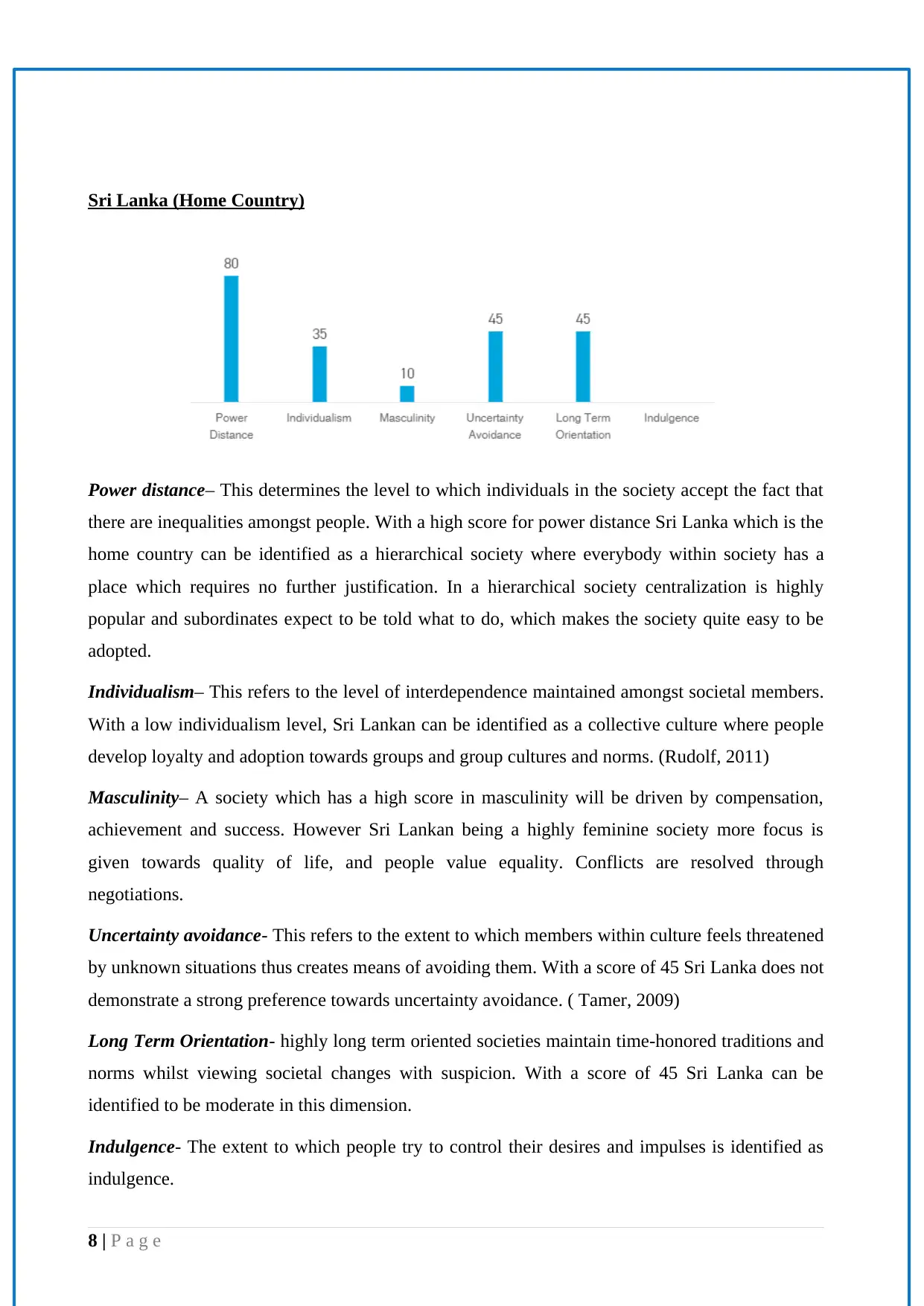
Sri Lanka (Home Country)
Power distance– This determines the level to which individuals in the society accept the fact that
there are inequalities amongst people. With a high score for power distance Sri Lanka which is the
home country can be identified as a hierarchical society where everybody within society has a
place which requires no further justification. In a hierarchical society centralization is highly
popular and subordinates expect to be told what to do, which makes the society quite easy to be
adopted.
Individualism– This refers to the level of interdependence maintained amongst societal members.
With a low individualism level, Sri Lankan can be identified as a collective culture where people
develop loyalty and adoption towards groups and group cultures and norms. (Rudolf, 2011)
Masculinity– A society which has a high score in masculinity will be driven by compensation,
achievement and success. However Sri Lankan being a highly feminine society more focus is
given towards quality of life, and people value equality. Conflicts are resolved through
negotiations.
Uncertainty avoidance- This refers to the extent to which members within culture feels threatened
by unknown situations thus creates means of avoiding them. With a score of 45 Sri Lanka does not
demonstrate a strong preference towards uncertainty avoidance. ( Tamer, 2009)
Long Term Orientation- highly long term oriented societies maintain time-honored traditions and
norms whilst viewing societal changes with suspicion. With a score of 45 Sri Lanka can be
identified to be moderate in this dimension.
Indulgence- The extent to which people try to control their desires and impulses is identified as
indulgence.
8 | P a g e
Power distance– This determines the level to which individuals in the society accept the fact that
there are inequalities amongst people. With a high score for power distance Sri Lanka which is the
home country can be identified as a hierarchical society where everybody within society has a
place which requires no further justification. In a hierarchical society centralization is highly
popular and subordinates expect to be told what to do, which makes the society quite easy to be
adopted.
Individualism– This refers to the level of interdependence maintained amongst societal members.
With a low individualism level, Sri Lankan can be identified as a collective culture where people
develop loyalty and adoption towards groups and group cultures and norms. (Rudolf, 2011)
Masculinity– A society which has a high score in masculinity will be driven by compensation,
achievement and success. However Sri Lankan being a highly feminine society more focus is
given towards quality of life, and people value equality. Conflicts are resolved through
negotiations.
Uncertainty avoidance- This refers to the extent to which members within culture feels threatened
by unknown situations thus creates means of avoiding them. With a score of 45 Sri Lanka does not
demonstrate a strong preference towards uncertainty avoidance. ( Tamer, 2009)
Long Term Orientation- highly long term oriented societies maintain time-honored traditions and
norms whilst viewing societal changes with suspicion. With a score of 45 Sri Lanka can be
identified to be moderate in this dimension.
Indulgence- The extent to which people try to control their desires and impulses is identified as
indulgence.
8 | P a g e
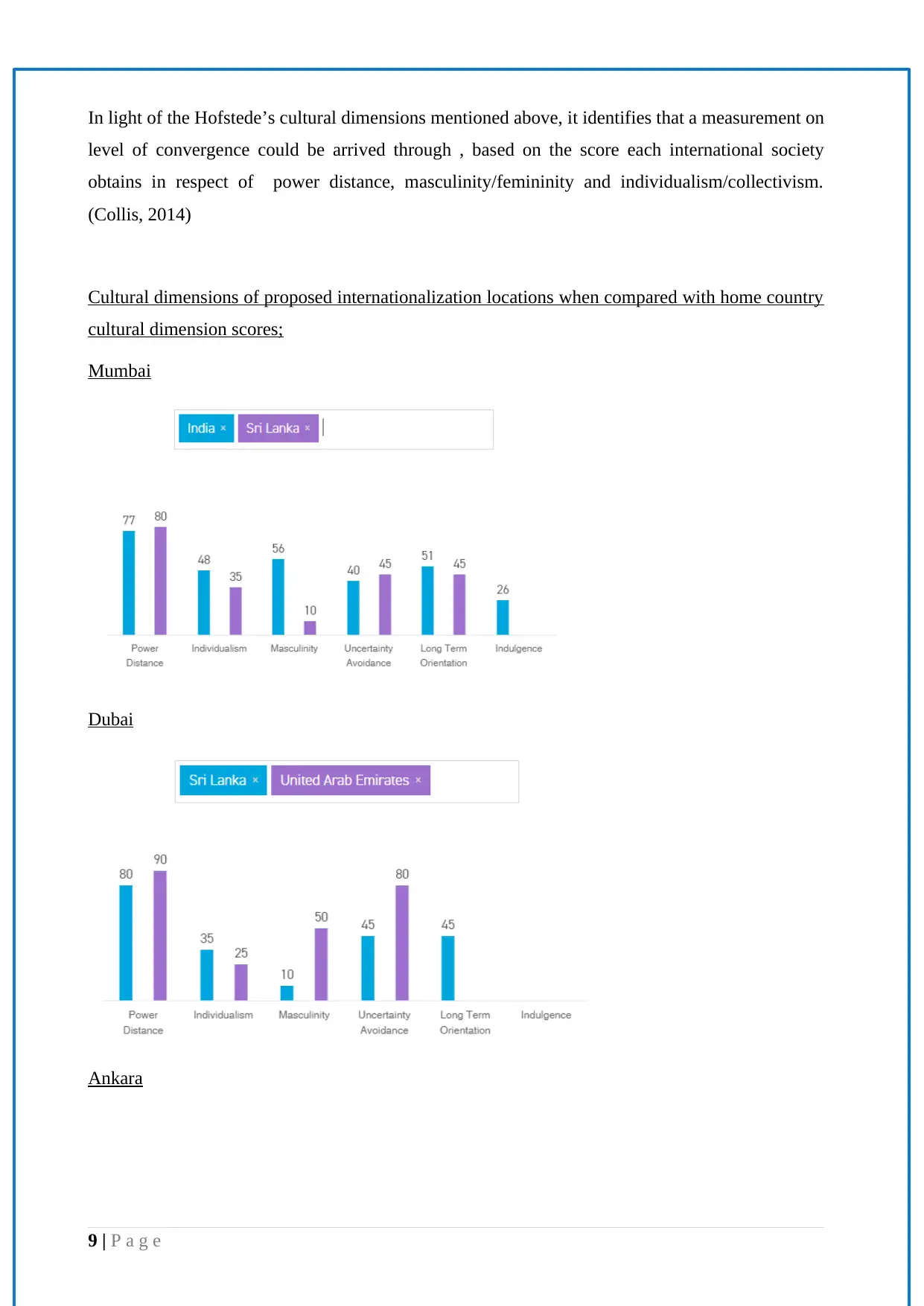
In light of the Hofstede’s cultural dimensions mentioned above, it identifies that a measurement on
level of convergence could be arrived through , based on the score each international society
obtains in respect of power distance, masculinity/femininity and individualism/collectivism.
(Collis, 2014)
Cultural dimensions of proposed internationalization locations when compared with home country
cultural dimension scores;
Mumbai
Dubai
Ankara
9 | P a g e
level of convergence could be arrived through , based on the score each international society
obtains in respect of power distance, masculinity/femininity and individualism/collectivism.
(Collis, 2014)
Cultural dimensions of proposed internationalization locations when compared with home country
cultural dimension scores;
Mumbai
Dubai
Ankara
9 | P a g e
⊘ This is a preview!⊘
Do you want full access?
Subscribe today to unlock all pages.

Trusted by 1+ million students worldwide
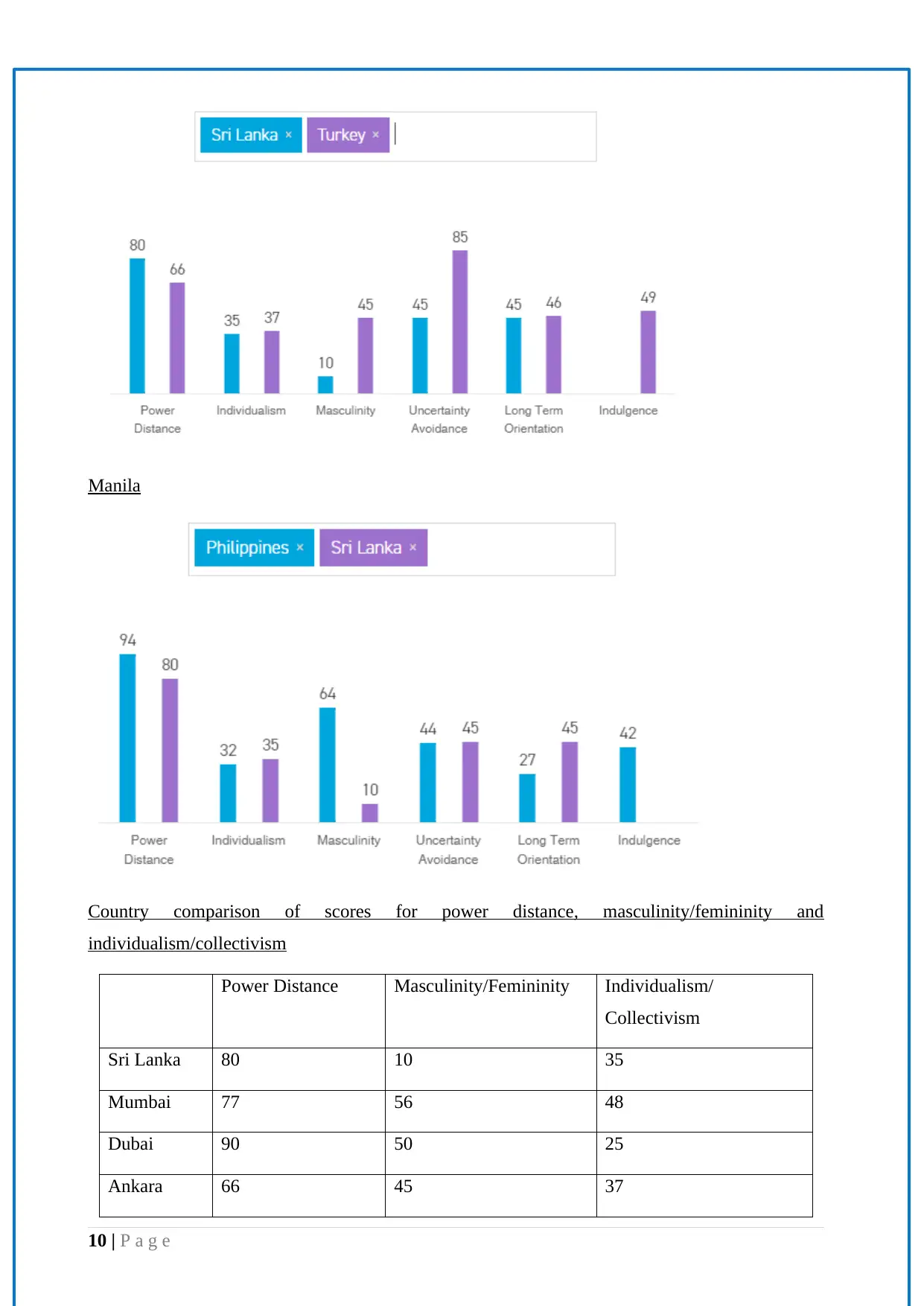
Manila
Country comparison of scores for power distance, masculinity/femininity and
individualism/collectivism
Power Distance Masculinity/Femininity Individualism/
Collectivism
Sri Lanka 80 10 35
Mumbai 77 56 48
Dubai 90 50 25
Ankara 66 45 37
10 | P a g e
Country comparison of scores for power distance, masculinity/femininity and
individualism/collectivism
Power Distance Masculinity/Femininity Individualism/
Collectivism
Sri Lanka 80 10 35
Mumbai 77 56 48
Dubai 90 50 25
Ankara 66 45 37
10 | P a g e
Paraphrase This Document
Need a fresh take? Get an instant paraphrase of this document with our AI Paraphraser
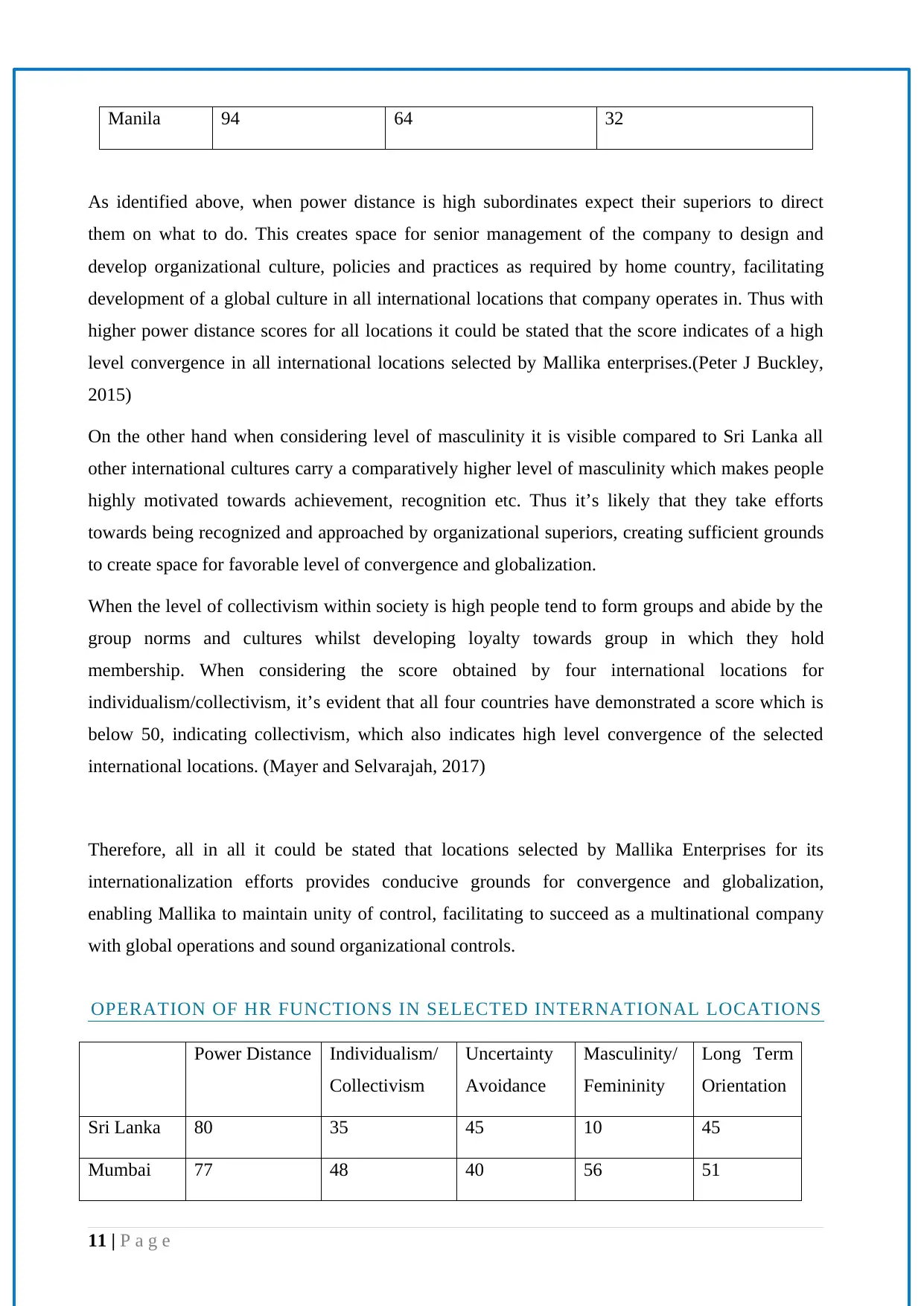
Manila 94 64 32
As identified above, when power distance is high subordinates expect their superiors to direct
them on what to do. This creates space for senior management of the company to design and
develop organizational culture, policies and practices as required by home country, facilitating
development of a global culture in all international locations that company operates in. Thus with
higher power distance scores for all locations it could be stated that the score indicates of a high
level convergence in all international locations selected by Mallika enterprises.(Peter J Buckley,
2015)
On the other hand when considering level of masculinity it is visible compared to Sri Lanka all
other international cultures carry a comparatively higher level of masculinity which makes people
highly motivated towards achievement, recognition etc. Thus it’s likely that they take efforts
towards being recognized and approached by organizational superiors, creating sufficient grounds
to create space for favorable level of convergence and globalization.
When the level of collectivism within society is high people tend to form groups and abide by the
group norms and cultures whilst developing loyalty towards group in which they hold
membership. When considering the score obtained by four international locations for
individualism/collectivism, it’s evident that all four countries have demonstrated a score which is
below 50, indicating collectivism, which also indicates high level convergence of the selected
international locations. (Mayer and Selvarajah, 2017)
Therefore, all in all it could be stated that locations selected by Mallika Enterprises for its
internationalization efforts provides conducive grounds for convergence and globalization,
enabling Mallika to maintain unity of control, facilitating to succeed as a multinational company
with global operations and sound organizational controls.
OPERATION OF HR FUNCTIONS IN SELECTED INTERNATIONAL LOCATIONS
Power Distance Individualism/
Collectivism
Uncertainty
Avoidance
Masculinity/
Femininity
Long Term
Orientation
Sri Lanka 80 35 45 10 45
Mumbai 77 48 40 56 51
11 | P a g e
As identified above, when power distance is high subordinates expect their superiors to direct
them on what to do. This creates space for senior management of the company to design and
develop organizational culture, policies and practices as required by home country, facilitating
development of a global culture in all international locations that company operates in. Thus with
higher power distance scores for all locations it could be stated that the score indicates of a high
level convergence in all international locations selected by Mallika enterprises.(Peter J Buckley,
2015)
On the other hand when considering level of masculinity it is visible compared to Sri Lanka all
other international cultures carry a comparatively higher level of masculinity which makes people
highly motivated towards achievement, recognition etc. Thus it’s likely that they take efforts
towards being recognized and approached by organizational superiors, creating sufficient grounds
to create space for favorable level of convergence and globalization.
When the level of collectivism within society is high people tend to form groups and abide by the
group norms and cultures whilst developing loyalty towards group in which they hold
membership. When considering the score obtained by four international locations for
individualism/collectivism, it’s evident that all four countries have demonstrated a score which is
below 50, indicating collectivism, which also indicates high level convergence of the selected
international locations. (Mayer and Selvarajah, 2017)
Therefore, all in all it could be stated that locations selected by Mallika Enterprises for its
internationalization efforts provides conducive grounds for convergence and globalization,
enabling Mallika to maintain unity of control, facilitating to succeed as a multinational company
with global operations and sound organizational controls.
OPERATION OF HR FUNCTIONS IN SELECTED INTERNATIONAL LOCATIONS
Power Distance Individualism/
Collectivism
Uncertainty
Avoidance
Masculinity/
Femininity
Long Term
Orientation
Sri Lanka 80 35 45 10 45
Mumbai 77 48 40 56 51
11 | P a g e
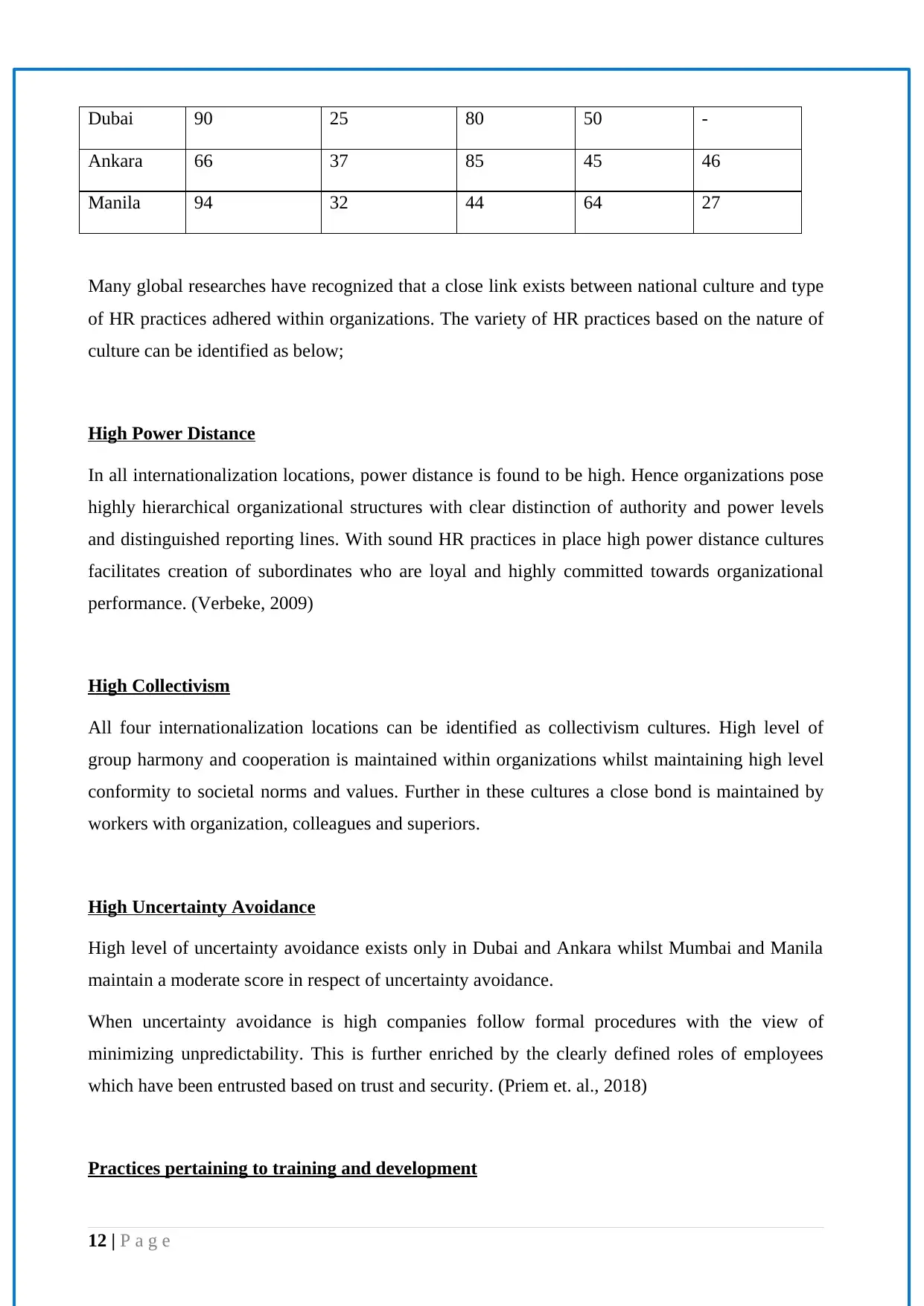
Dubai 90 25 80 50 -
Ankara 66 37 85 45 46
Manila 94 32 44 64 27
Many global researches have recognized that a close link exists between national culture and type
of HR practices adhered within organizations. The variety of HR practices based on the nature of
culture can be identified as below;
High Power Distance
In all internationalization locations, power distance is found to be high. Hence organizations pose
highly hierarchical organizational structures with clear distinction of authority and power levels
and distinguished reporting lines. With sound HR practices in place high power distance cultures
facilitates creation of subordinates who are loyal and highly committed towards organizational
performance. (Verbeke, 2009)
High Collectivism
All four internationalization locations can be identified as collectivism cultures. High level of
group harmony and cooperation is maintained within organizations whilst maintaining high level
conformity to societal norms and values. Further in these cultures a close bond is maintained by
workers with organization, colleagues and superiors.
High Uncertainty Avoidance
High level of uncertainty avoidance exists only in Dubai and Ankara whilst Mumbai and Manila
maintain a moderate score in respect of uncertainty avoidance.
When uncertainty avoidance is high companies follow formal procedures with the view of
minimizing unpredictability. This is further enriched by the clearly defined roles of employees
which have been entrusted based on trust and security. (Priem et. al., 2018)
Practices pertaining to training and development
12 | P a g e
Ankara 66 37 85 45 46
Manila 94 32 44 64 27
Many global researches have recognized that a close link exists between national culture and type
of HR practices adhered within organizations. The variety of HR practices based on the nature of
culture can be identified as below;
High Power Distance
In all internationalization locations, power distance is found to be high. Hence organizations pose
highly hierarchical organizational structures with clear distinction of authority and power levels
and distinguished reporting lines. With sound HR practices in place high power distance cultures
facilitates creation of subordinates who are loyal and highly committed towards organizational
performance. (Verbeke, 2009)
High Collectivism
All four internationalization locations can be identified as collectivism cultures. High level of
group harmony and cooperation is maintained within organizations whilst maintaining high level
conformity to societal norms and values. Further in these cultures a close bond is maintained by
workers with organization, colleagues and superiors.
High Uncertainty Avoidance
High level of uncertainty avoidance exists only in Dubai and Ankara whilst Mumbai and Manila
maintain a moderate score in respect of uncertainty avoidance.
When uncertainty avoidance is high companies follow formal procedures with the view of
minimizing unpredictability. This is further enriched by the clearly defined roles of employees
which have been entrusted based on trust and security. (Priem et. al., 2018)
Practices pertaining to training and development
12 | P a g e
⊘ This is a preview!⊘
Do you want full access?
Subscribe today to unlock all pages.

Trusted by 1+ million students worldwide
1 out of 17
Your All-in-One AI-Powered Toolkit for Academic Success.
+13062052269
info@desklib.com
Available 24*7 on WhatsApp / Email
![[object Object]](/_next/static/media/star-bottom.7253800d.svg)
Unlock your academic potential
Copyright © 2020–2025 A2Z Services. All Rights Reserved. Developed and managed by ZUCOL.

